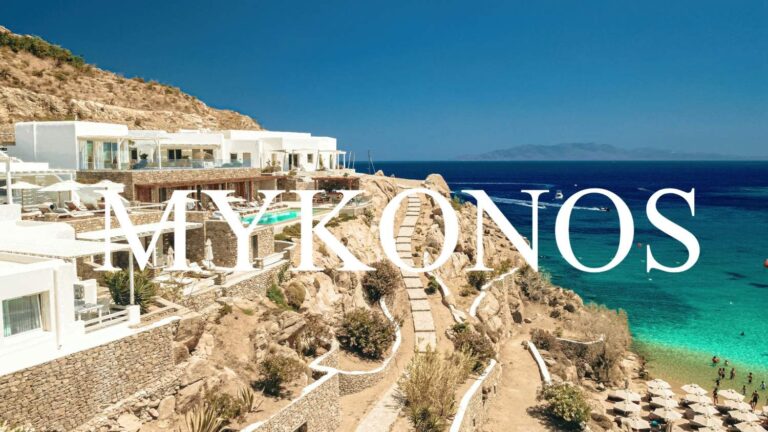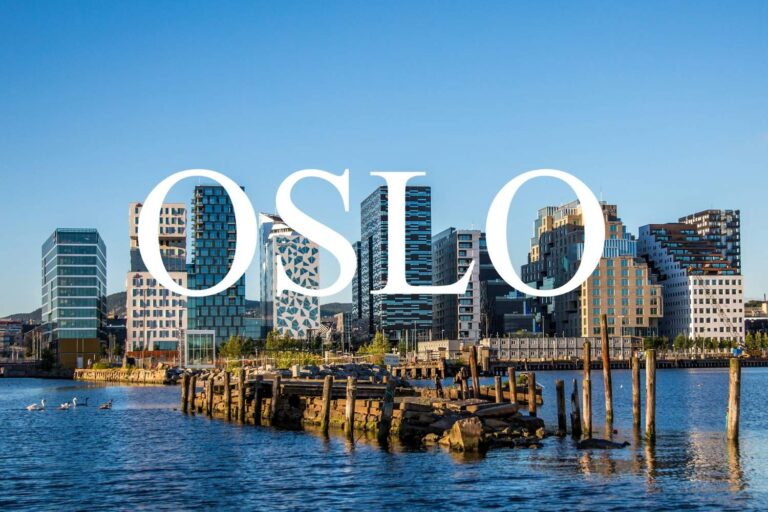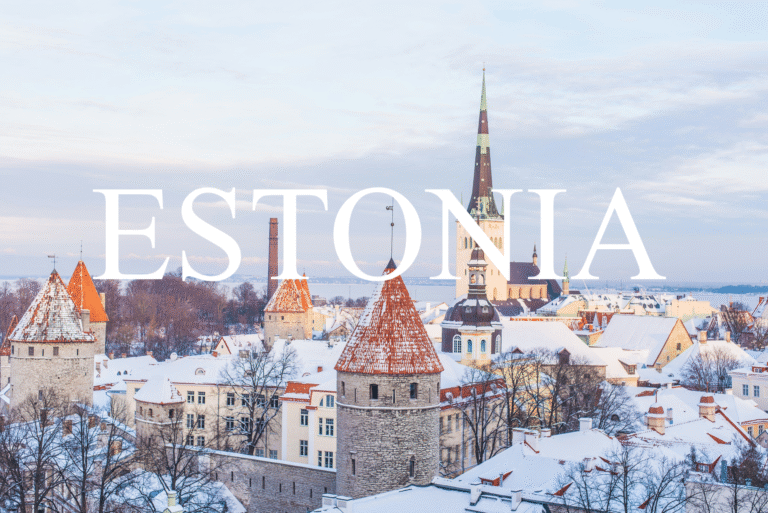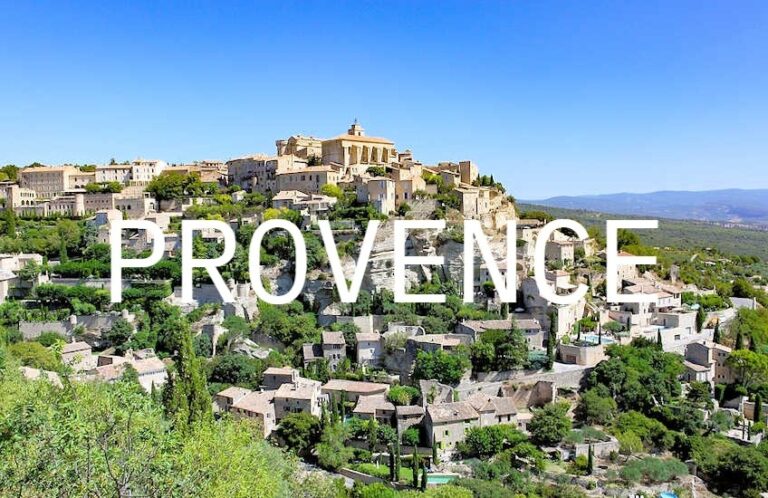
Prague, often called the “City of a Hundred Spires,” is a captivating European gem renowned for its fairytale-like architecture, winding cobblestone streets, and a rich history that spans centuries. This Czech capital enchants visitors with its stunning Gothic cathedrals, grand Baroque palaces, and charming old-town squares that seem frozen in time. Whether you’re wandering across the iconic Charles Bridge at sunrise, savoring a cup of coffee in a cozy café tucked away in a medieval alley, or exploring vibrant cultural festivals, Prague offers an unforgettable blend of romance and history.
The city’s unique atmosphere is enhanced by its thriving arts scene, lively nightlife, and welcoming locals who bring warmth to every corner. From the majestic Prague Castle overlooking the city to the bustling markets and hidden courtyards, Prague invites travelers to immerse themselves in its magical ambiance. Perfect for history buffs, art lovers, and romantics alike, Prague remains one of Europe’s most treasured destinations, offering experiences that stay with you long after you leave.
🗓️ Best Time to Visit Prague
The best time to visit Prague depends on what kind of experience you’re seeking:
- 🌸 Spring (April–June): Mild weather, blooming gardens, and fewer tourists. Ideal for walking tours and photography.
- ☀️ Summer (July–August): Warmest months with festivals and outdoor events, but also the most crowded.
- 🍁 Autumn (September–October): Fewer tourists, golden fall colors, and cool but comfortable weather.
- ❄️ Winter (December–February): Cold but magical, especially during the Christmas markets with twinkling lights and hot mulled wine.
💰 Currency & Essential Info
- Currency: Czech Koruna (CZK)
- Exchange Rate (June 2025): 1 USD ≈ 22 CZK
- Language: Czech (English widely spoken in tourist areas)
- Public Transport: Efficient and cheap – trams, buses, and metro available
- Average Daily Budget:
- Budget: 800–1200 CZK
- Mid-range: 1500–2500 CZK
- Luxury: 3000+ CZK
💡 Tip: Prague is very walkable, but the transport pass (24 or 72-hour) is perfect for exploring farther areas.
🏙️ 10 Best Places to Visit in Prague
Prague Castle (Pražský hrad)

Photo by Kaveh Rasooli on Unsplash
Dominating the skyline of Prague, Prague Castle (Pražský hrad) is not just a castle but a symbol of the Czech Republic’s rich history and cultural heritage. Perched high above the Vltava River, this sprawling complex is one of the largest ancient castles in the world and a UNESCO World Heritage site. From royal palaces to the iconic St. Vitus Cathedral, Prague Castle offers a captivating journey through centuries of art, architecture, and history.
🌟 Highlights of Prague Castle
• St. Vitus Cathedral
One of the most iconic Gothic structures in Europe, St. Vitus Cathedral is the spiritual heart of Prague Castle. The cathedral’s intricate stained glass windows, impressive spires, and stunning interior make it a must-see. Don’t miss the opportunity to climb the tower for panoramic views of the city.
• Old Royal Palace
Step back in time as you explore the Old Royal Palace, where Czech kings and emperors once resided. Highlights include the Vladislav Hall, used for coronations and royal ceremonies, and the Czech kings’ crown jewels.
• Golden Lane
Wander through the charming Golden Lane, a medieval street lined with tiny, colorful houses. This area once housed castle guards, alchemists, and goldsmiths, and today it offers a glimpse into the daily life of Prague’s past.
• Royal Gardens
Escape the crowds by strolling through the Royal Gardens, a beautifully landscaped area that includes the Garden on the Ramparts and the Ball Game Hall. The gardens are a peaceful oasis with fountains, flowers, and great views of the castle.
• Castle District (Hradčany)
The area surrounding the castle, known as Hradčany, is filled with beautiful Baroque and Renaissance buildings, including the Loreto Sanctuary and the Strahov Monastery, making it an ideal area to explore after touring the castle.
🚗 How to Get There
• By Tram:
Take Tram 22, which stops near the Prague Castle. The nearest tram stops are Pražský hrad and Malostranská.
• By Metro:
You can take the A Line to Malostranská Station, which is about a 10-minute walk from the castle complex.
• On Foot:
If you’re staying in the city center, walking to Prague Castle is highly recommended. It’s about a 15-minute walk from Charles Bridge to the castle, and the route offers scenic views of Prague’s historic districts.
🕒 Visitor Information
• Opening Hours:
Prague Castle is open daily from 9:00 AM to 5:00 PM. The St. Vitus Cathedral is open until 4:30 PM, but it’s worth checking the website for special hours or events.
• Entry Fee:
Entry to the castle grounds is free, but there are fees for visiting specific areas like the St. Vitus Cathedral or the Old Royal Palace. A full ticket for the entire complex costs around 250 CZK (about 10 EUR). Discounts are available for students and seniors.
• Recommended Visit Duration:
To fully explore Prague Castle and its various attractions, plan for about 3-4 hours. If you want to take your time with the Royal Gardens or visit the surrounding areas, a half-day visit is ideal.
💡 Travel Tips
• 🎟️ Buy Tickets in Advance:
During peak tourist seasons, the lines for tickets can get long. Consider purchasing tickets online to save time and skip the queues.
• 👟 Wear Comfortable Shoes:
The castle grounds are extensive, with cobblestone paths and steep stairs in some areas. Comfortable footwear is essential for a full day of exploration.
• 📸 Bring Your Camera:
With its stunning architecture and sweeping views of Prague, Prague Castle is a photographer’s paradise. Don’t forget to snap photos, especially from the castle’s Southern Gardens for a perfect shot of the city skyline.
• 🏰 Check for Special Events:
Prague Castle often hosts cultural events, including concerts, exhibitions, and ceremonies. Make sure to check the schedule during your visit for any special performances or activities.
Prague Castle is more than just a historic monument—it’s the beating heart of the Czech capital, offering a fascinating glimpse into the country’s royal past. Whether you’re captivated by medieval architecture, enchanted by panoramic city views, or intrigued by the rich cultural experiences, a visit to Pražský hrad is one you won’t forget.
Charles Bridge (Karlův most)
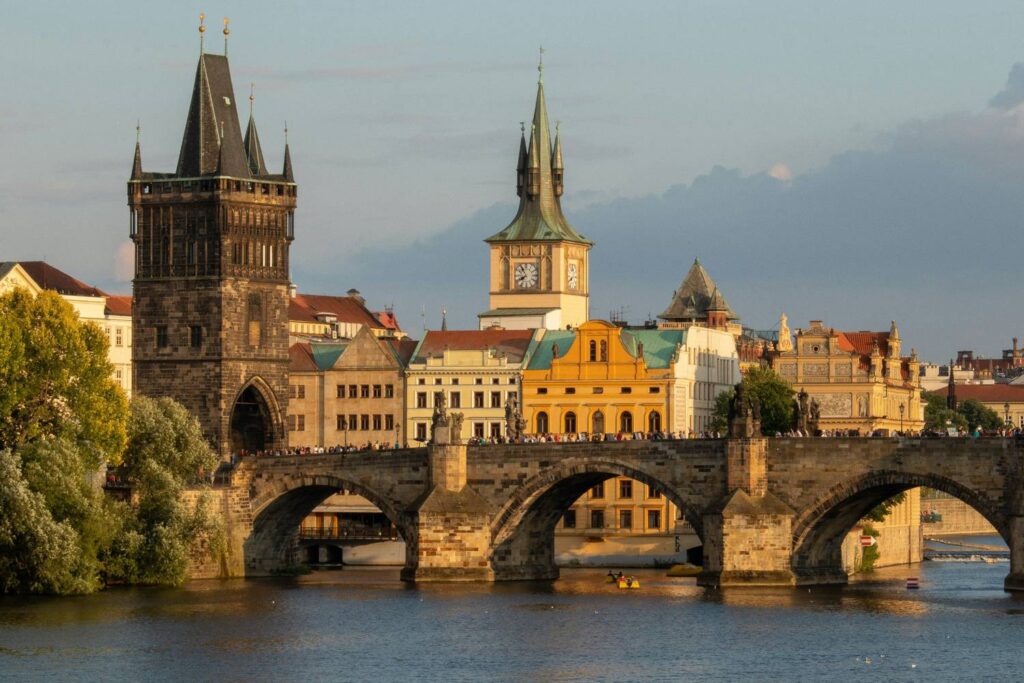
Photo by Martin Krchnacek on Unsplash
Spanning the Vltava River, Charles Bridge (Karlův most is one of Prague’s most iconic landmarks, drawing millions of visitors each year. This stunning medieval bridge, originally built in the 14th century, connects the Old Town with the Lesser Town (Malá Strana), offering a breathtaking backdrop of Prague Castle and the city’s charming skyline. Known for its architectural beauty, historic significance, and picturesque views, the Charles Bridge is an essential part of any Prague visit, whether you’re strolling across it during the day or admiring its illuminated beauty at night.
🌟 Highlights of Charles Bridge
• 🏰 Stunning Architecture
Admire the bridge’s Gothic arches, magnificent statues of saints, and intricate stonework—each element contributing to its medieval charm.
• 🌄 Scenic Views
Enjoy panoramic views of Prague Castle, the Vltava River, and the city’s red rooftops, particularly captivating during sunrise or sunset.
• 🎨 Statues of Saints
Walk alongside 30 statues, including figures like St. John Nepomuk, offering a touch of religious history and artistic craftsmanship.
• 🚶 Bridge as a Meeting Point
Charles Bridge is always alive with musicians, artists, and street performers, making it a vibrant and lively place to visit.
• 🏙️ Proximity to Major Attractions
The bridge conveniently connects Prague’s Old Town with the Lesser Town and leads to the magnificent Prague Castle, just a short walk away.
🚗 How to Get There
• Public Transport:
The bridge is easily accessible via tram stops at Karlovy lázně or Malostranská. The Staroměstská metro station is also nearby.
• On Foot:
Charles Bridge is located in Prague’s historical center, making it easy to walk to from major tourist spots like Old Town Square and Wenceslas Square.
🕒 Visitor Information
• Opening Hours:
Open 24 hours a day, but best to visit in the early morning or late evening to avoid crowds.
• Entry Fee:
Free to cross; however, if you’re interested in learning more about the history and statues, guided tours are available for a fee.
• Recommended Visit Duration:
Allow about 30 minutes to 1 hour to cross the bridge and appreciate the views and statues along the way.
💡 Travel Tips
• 📸 Best Time for Photos:
For the best photos, visit at sunrise or sunset when the light is soft and the bridge is less crowded.
• 👟 Wear Comfortable Shoes:
There are cobblestones, so sturdy shoes are recommended, especially during the summer when the bridge can get busy.
• 🧭 Combine with Nearby Sights:
Combine your visit with a tour of Prague Castle, a walk through Lesser Town, or a visit to the Old Town Square.
• 🎨 Street Performers and Artists:
Keep an eye out for local artists, musicians, and performers, who add to the bridge’s lively atmosphere.
The Charles Bridge (Karlův most) is not just a bridge—it’s an iconic symbol of Prague’s rich history and artistic legacy. Whether you’re admiring its stunning views, exploring the statues, or just soaking in the atmosphere, it’s a place that captures the essence of the city. A must-see for any traveler, the bridge offers both historical wonder and natural beauty in one unforgettable experience.
Old Town Square (Staroměstské náměstí)
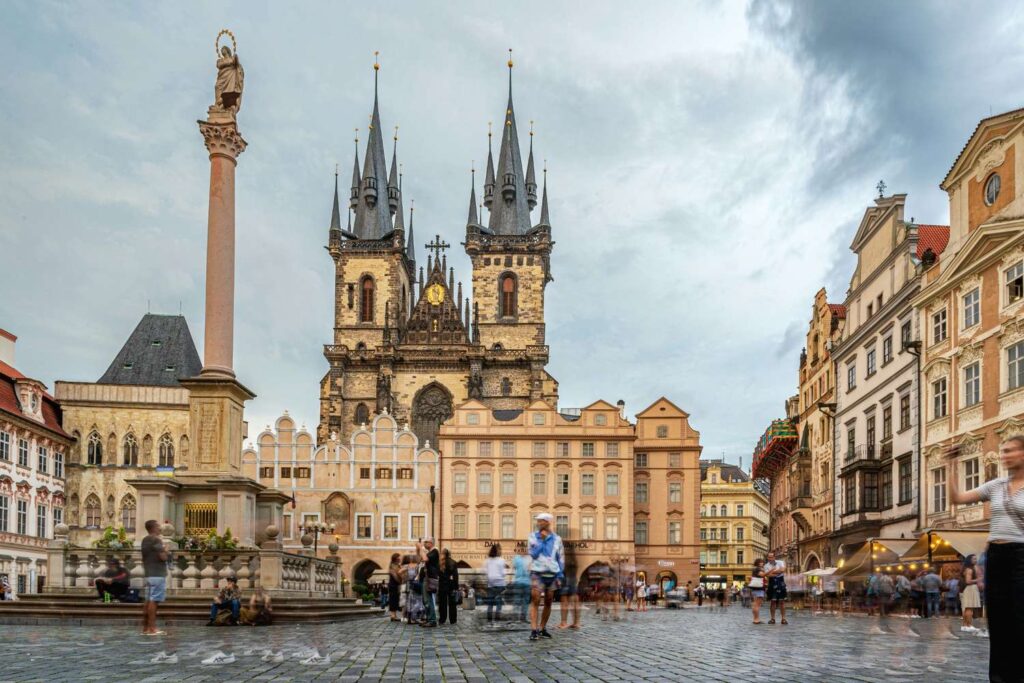
Photo by Patrick Pahlke on Unsplash
Nestled in the heart of Prague, Old Town Square (Staroměstské náměstí) is the beating heart of the city’s rich history, surrounded by centuries-old architecture, charming streets, and world-famous landmarks. As one of the most popular attractions in the Czech capital, this lively square has been a gathering place for centuries and continues to be a vibrant hub for both locals and tourists alike. Whether you’re marveling at the Astronomical Clock, relaxing at a café, or simply soaking in the atmosphere, Old Town Square offers an unforgettable experience.
🌟 Highlights of Old Town Square
• Astronomical Clock (Prague Orloj)
One of Prague’s most iconic landmarks, the Astronomical Clock is an extraordinary medieval mechanism that dates back to 1410. Every hour, the clock comes to life as its figures move, attracting crowds who eagerly watch the show. Be sure to catch the chimes and the procession of the 12 Apostles!
• Týn Church (Church of Our Lady Before Týn)
Dominating the square with its twin spires, the Týn Church is an iconic example of Gothic architecture. Visitors can admire its intricate facade and visit the church to explore its stunning interior, complete with breathtaking altars and paintings.
• St. Nicholas Church
A baroque masterpiece, St. Nicholas Church stands proudly at the southern end of the square. Its stunning architecture and impressive interior, with a richly decorated dome and beautiful frescoes, are a must-see for visitors.
• Old Town Hall
The Old Town Hall, with its beautifully ornate facade, is a historical gem. Visitors can explore its chambers, including the Hall of Mirrors and climb the tower for panoramic views of the city, offering a bird’s-eye view of Prague Castle and the Vltava River.
• Statue of Jan Hus
Located in the center of the square, the Statue of Jan Hus honors the Czech reformer who was burned at the stake in 1415. The statue stands as a symbol of Czech national pride and history, making it an important landmark in the square.
🚶♂️ How to Get There
• By Metro:
Take the A Line (Green Line) to Staroměstská Station, which is just a short walk from the square.
• By Tram:
Trams 17, 18, and 53 pass by Staroměstské náměstí. The nearest tram stops are Staroměstská and Můstek.
• On Foot:
If you’re staying in central Prague, it’s easy to walk to Old Town Square. It’s located within walking distance from Charles Bridge and Wenceslas Square.
🕒 Visitor Information
• Opening Hours:
Old Town Square is open 24/7, and there’s no entry fee to visit the square itself. However, the opening hours for attractions like the Astronomical Clock and Old Town Hall vary. The clock performs every hour, and the Old Town Hall is open daily from 9:00 AM to 6:00 PM.
• Entry Fee:
The square itself is free to explore, but tickets are required for entry to the Old Town Hall and other attractions. Entry to the Old Town Hall Tower costs approximately 250 CZK (about 10 EUR).
• Recommended Visit Duration:
Plan for at least 1–2 hours to explore the square and its main landmarks. If you wish to visit the Old Town Hall Tower or take in more of the surrounding streets, allow more time.
💡 Travel Tips
• 🎟️ Avoid Peak Hours:
The square can get crowded, especially during the peak tourist seasons. Early mornings or late afternoons are the best times to visit if you prefer fewer crowds.
• 📸 Perfect for Photography:
Old Town Square offers numerous photo opportunities, from the Astronomical Clock to the dramatic spires of the Týn Church. Don’t forget to take a picture of the square’s charming buildings and lively atmosphere.
• ☕ Cafés and Restaurants:
The square is home to a variety of cafés and restaurants, perfect for enjoying traditional Czech food or a coffee while watching the world go by. Be sure to try a cup of Czech coffee or indulge in Trdelník, a sweet pastry often sold by street vendors.
• 🛍️ Souvenir Shopping:
There are several souvenir shops around the square where you can pick up Czech crystal, handmade crafts, or local artwork. Just be mindful of the prices as they may be slightly higher due to the prime location.
Old Town Square (Staroměstské náměstí) is more than just a popular tourist destination—it’s the soul of Prague, offering a glimpse into the city’s fascinating past while also being a lively hub of culture and activity. Whether you’re admiring the Astronomical Clock, visiting the beautiful St. Nicholas Church, or simply soaking up the historic atmosphere, the square promises an unforgettable experience for visitors of all ages.
St. Vitus Cathedral
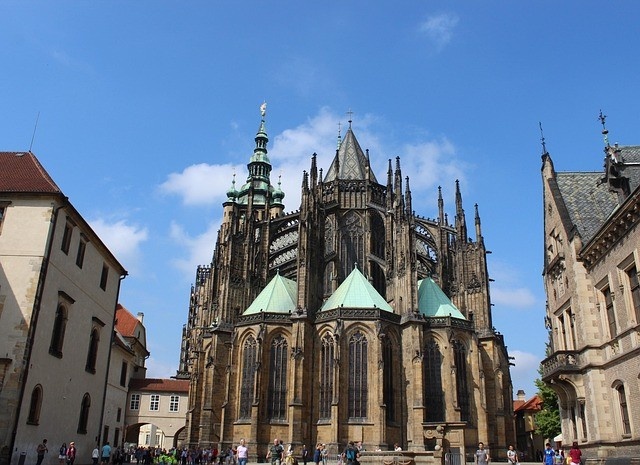
Located within the walls of Prague Castle St. Vitus Cathedral (Katedrála svatého Víta) is one of the most impressive examples of Gothic architecture in Europe. With its towering spires, intricate stained glass windows, and a rich history dating back to the 14th century, the cathedral stands as a symbol of the Czech Republic’s spiritual and cultural heritage. Whether you’re captivated by its grandeur, marveling at its detailed interior, or exploring its historical significance, St. Vitus Cathedral offers a mesmerizing journey through time.
🌟 Highlights of St. Vitus Cathedral
• 🏰 Gothic Architecture
Admire the cathedral’s awe-inspiring Gothic design, including its tall spires, pointed arches, and the stunning South Tower, which offers panoramic views of Prague.
• 🎨 Stained Glass Windows
Marvel at the vibrant stained glass windows, particularly the Window of St. Wenceslas, which is an artistic masterpiece depicting scenes from the life of the saint.
• 🏛️ Royal Mausoleum
The cathedral is the final resting place for many Czech kings, queens, and emperors. Visit the royal tombs to learn about the country’s monarchs.
• 💎 St. Vitus Chapel
Step inside the Chapel of St. Wenceslas, a richly decorated space adorned with jewels, including the famous St. Wenceslas Crown, and explore its historic significance.
• ⛪ Gothic Vaults and Decor
The cathedral’s interior boasts stunning vaulted ceilings, delicate stonework, and a beautifully intricate altar, showcasing the craftsmanship of medieval architects and artists.
🚗 How to Get There
• Public Transport:
The closest metro station is Malostranská (Line A), followed by a short walk through the grounds of Prague Castle. Trams also stop near the castle complex.
• On Foot:
Located within Prague Castle, St. Vitus Cathedral is easily accessible from the castle grounds. The cathedral is also a short walk from the Charles Bridge.
🕒 Visitor Information
• Opening Hours:
St. Vitus Cathedral is generally open from 9:00 AM to 5:00 PM, with extended hours during the summer months.
• Entry Fee:
Entry to the cathedral is free, but there is a fee for accessing the St. Vitus Tower and some parts of the cathedral. A ticket for the Prague Castle complex, which includes St. Vitus, is available.
• Recommended Visit Duration:
Allocate about 1 to 1.5 hours to explore the cathedral, including the royal tombs, stained glass, and chapels.
💡 Travel Tips
• 🎟️ Buy Tickets in Advance:
To avoid long lines, especially in peak season, purchase a combined ticket for Prague Castle that includes St. Vitus Cathedral.
• 🧭 Visit the Tower:
Climb to the top of the South Tower for spectacular views of Prague and the surrounding areas. Be prepared for a steep climb!
• 👟 Wear Comfortable Shoes:
The cathedral’s floors can be uneven, and you’ll be doing a fair amount of walking and possibly climbing.
• 🌞 Best Time to Visit:
Arrive early to avoid the crowds or plan a late afternoon visit when the light streaming through the windows creates a magical atmosphere.
St. Vitus Cathedral is one of Prague’s most awe-inspiring and historically significant landmarks. Whether you’re standing in its vast nave, taking in the intricate artwork, or learning about Czech history through its royal connections, the cathedral offers an unforgettable experience that will stay with you long after your visit. A true jewel of Prague, it stands as a testament to the city’s rich cultural and religious legacy.
Lennon Wall

Nestled in the heart of Prague, the Lennon Wall is a vibrant symbol of peace, love, and the spirit of rebellion. This ever-evolving canvas, covered in graffiti, artwork, and John Lennon-inspired messages, is located near the Czech Embassy and the Kampa Island. It started as a tribute to the late Beatles legend, John Lennon, and over the years, it has transformed into a living, breathing expression of political and personal freedom. The wall has become one of Prague’s most unique and colorful landmarks.
🌟 Highlights of the Lennon Wall
• A Tribute to John Lennon
Originally painted in 1980, following the assassination of John Lennon, the wall became an unofficial shrine to the Beatle. Early designs featured portraits of Lennon, quotes from his songs, and messages of peace. Over the years, it evolved into a much broader symbol of resistance against oppression, especially during the Czech Velvet Revolution.
• Evolving Street Art
What makes the Lennon Wall so unique is that it’s always changing. Artists and visitors from all over the world have added their own artwork, quotes, and personal messages over the years. The wall constantly evolves, reflecting the political and social sentiments of each era. The colorful graffiti and images offer an ever-changing spectacle that feels alive.
• Messages of Peace and Freedom
The wall is filled with powerful messages, not just in the form of colorful graffiti but also peace symbols, quotes from John Lennon and other freedom fighters, and expressions of hope and resistance. It’s a peaceful space where individuals can leave their mark, contributing to a larger conversation about human rights, unity, and the fight for freedom.
• Proximity to Kampa Island
The Lennon Wall is located near Kampa Island, a tranquil area of Prague where you can enjoy beautiful views of the Vltava River and Charles Bridge. After visiting the wall, take a peaceful stroll along the river or explore the island’s Kampa Museum, which showcases modern art.
🚶♂️ How to Get There
• By Metro:
Take the A Line (Green Line) to Malostranská Station, and from there, it’s just a 10-minute walk to the Lennon Wall.
• By Tram:
Tram lines 12, 15, and 20 stop at Malostranská, which is within walking distance of the wall.
• On Foot:
The Lennon Wall is within easy walking distance of Prague’s Old Town and Charles Bridge. It’s a scenic walk, with plenty of historic charm along the way.
🕒 Visitor Information
• Opening Hours:
The Lennon Wall is open 24/7, as it’s a public space, so you can visit at any time. However, it’s best to go during daylight to fully appreciate the artwork and vibrant colors.
• Entry Fee:
There is no entry fee to visit the Lennon Wall, making it a free attraction for all to enjoy.
• Recommended Visit Duration:
It typically takes around 15-30 minutes to admire the wall, depending on your interest in exploring the art and reading the messages. If you’re nearby, it’s worth a quick stop. Otherwise, take your time to fully absorb the creativity and history.
💡 Travel Tips
• 🎨 Respect the Wall:
The Lennon Wall is a space for peaceful expression. While it’s a place for visitors to add their own messages, it’s essential to approach it with respect for the artistic and historical significance.
• 📸 Perfect for Photos:
The wall is incredibly photogenic, especially with its vibrant colors and meaningful messages. It’s a great spot for photographers looking to capture Prague’s more artistic side.
• ☔ Weather Considerations:
Because the wall is outdoors, it’s best to check the weather before visiting. On rainy days, the wall might look a little different as some colors fade or blur, but the spirit of the place remains.
• 🖌️ Add Your Own Message:
If you’re inspired, feel free to contribute to the wall! Whether it’s a small tribute to John Lennon or a personal message of peace, the wall is open to all forms of self-expression. Just remember, the messages are always evolving, and your contribution may only last as long as the next coat of paint.
The Lennon Wall is more than just a colorful piece of street art. It’s a symbol of Prague’s resilience, creativity, and desire for freedom. A place where past and present intertwine, the wall offers a space for reflection and a testament to the power of art and music in the fight for peace and justice. Whether you’re a Beatles fan, an art lover, or someone who simply appreciates the beauty of human expression, the Lennon Wall is a must-see when visiting Prague.
Wenceslas Square
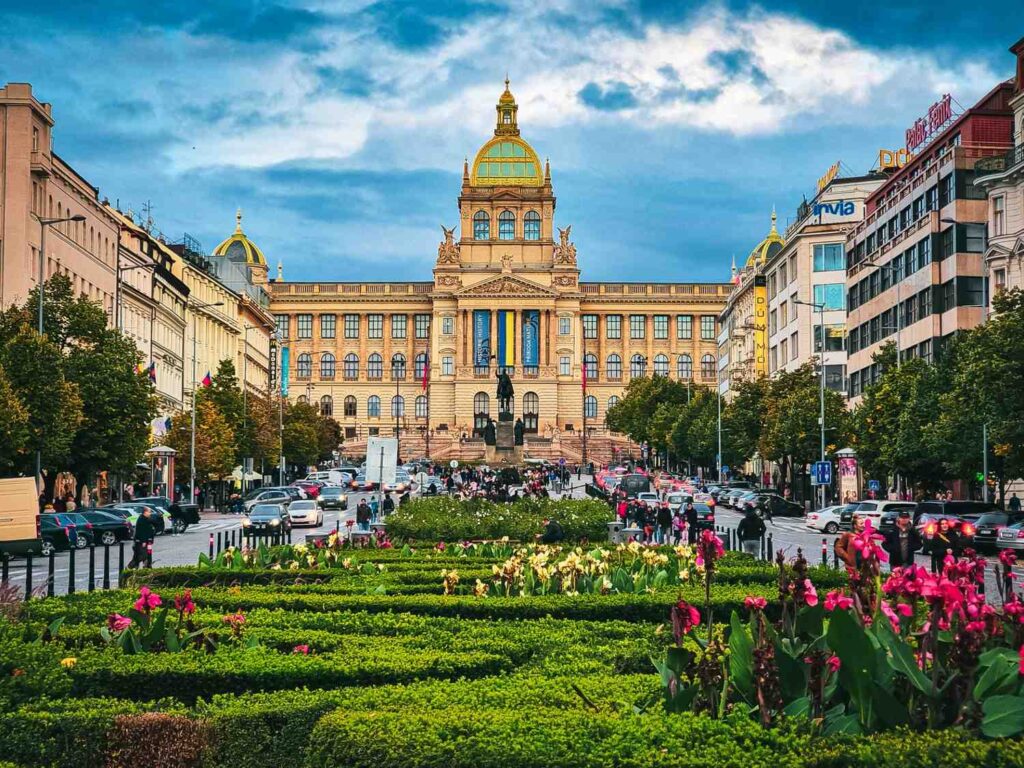
Photo by Tharun Thejus on Unsplash
Located in the New Town (Nové Město) of Prague, Wenceslas Square (Václavské náměstí) is not just a square; it’s a symbol of the city’s rich history, culture, and modern life. Stretching over 750 meters, this bustling boulevard is lined with shops, cafés, restaurants, and historic buildings. From its medieval origins to its role in major political events, Wenceslas Square offers an insightful glimpse into Prague’s past while serving as a lively focal point of the city’s contemporary energy.
🌟 Highlights of Wenceslas Square
• 🏛️ Historical Significance
Wenceslas Square has been the site of key historical events, including protests during the Velvet Revolution of 1989. It’s also home to statues and monuments that tell the story of Prague’s turbulent past.
• 👑 Statue of St. Wenceslas
At the square’s center stands an imposing statue of St. Wenceslas, the patron saint of Bohemia, mounted on horseback. It’s a popular spot for photos and reflection on Czech history.
• 🛍️ Shopping and Dining
Wenceslas Square is a major shopping hub in Prague, with everything from international brands to unique boutiques. You’ll also find a variety of cafés, restaurants, and bars serving Czech specialties and global cuisine.
• 🎭 Cultural Institutions
Visit the National Museum, located at the top of the square, where you can explore Czech history, art, and science. The square is also home to the Opera House and several theaters.
• 🎉 Vibrant Atmosphere
Whether it’s day or night, Wenceslas Square is always full of energy, with street performers, tourists, locals, and an array of events happening throughout the year.
🚗 How to Get There
• Public Transport:
Wenceslas Square is easily accessible by metro (line A or C, Muzeum or Wenceslas Square stations) and several tram lines. It’s also a short walk from Prague’s Old Town.
• On Foot:
The square is centrally located and easily walkable from many other tourist sites, including the Old Town Square and Charles Bridge.
🕒 Visitor Information
• Opening Hours:
The square itself is open 24/7, though nearby attractions like the National Museum are open from 10:00 AM to 6:00 PM.
• Entry Fee:
The square itself is free to explore, though tickets for cultural institutions like the National Museum or other museums around the square are separate.
• Recommended Visit Duration:
A visit to the square can be as short as 30 minutes to admire the sights, or you can spend several hours exploring the museums and shopping areas.
💡 Travel Tips
• 📸 Best Time for Photos:
The statue of St. Wenceslas and the National Museum are particularly stunning when lit up at night, creating a magical photo opportunity.
• 🎟️ Visit the National Museum:
Take time to visit the National Museum at the top of the square, which houses fascinating exhibits on Czech history and culture.
• 🛍️ Explore the Shops:
If you’re into shopping, Wenceslas Square is the perfect place to browse for Czech souvenirs, local products, or international fashion brands.
• 🍽️ Czech Cuisine:
Don’t miss the opportunity to sample traditional Czech dishes at one of the many restaurants around the square, such as svíčková (beef in creamy sauce) or trdelník (a sweet pastry).
Wenceslas Square is not only a significant historical landmark but also one of Prague’s most vibrant and dynamic areas. Whether you’re exploring its rich cultural institutions, enjoying the lively atmosphere, or reflecting on its role in Czech history, the square offers something for everyone. It’s a perfect blend of the old and the new, making it a must-visit spot for anyone in Prague.
Petrin Hill & Lookout Tower

Located just a short distance from the hustle and bustle of Prague’s Old Town, Petrin Hill offers visitors a peaceful retreat into nature, along with some of the best panoramic views of the city. Known for its beautiful gardens, wooded paths, and the Petrin Lookout Tower, this green oasis is perfect for a relaxing walk, a picnic, or a hike. Whether you’re enjoying the views from the tower or wandering the peaceful parkland, Petrin Hill is one of Prague’s most beloved spots for locals and tourists alike.
🌟 Highlights of Petrin Hill & Lookout Tower
• Petrin Lookout Tower (Petřínská rozhledna)
The Petrin Lookout Tower, often compared to Paris’s Eiffel Tower, is the hill’s crown jewel. Standing at 63.5 meters tall, the tower offers breathtaking 360-degree views of Prague. Visitors can climb to the top and gaze out over the Vltava River, Prague Castle, Charles Bridge, and the city’s iconic skyline. For those not up for the climb, there’s also an elevator that takes you almost to the top.
• Petrin Gardens and Rose Garden
At the base of the lookout tower lies a beautifully maintained rose garden and several other well-kept gardens that are perfect for leisurely strolls. The serene atmosphere and well-manicured grounds make this a perfect spot to relax, read a book, or have a picnic.
• The Mirror Maze (Zrcadlové bludiště)
For some fun and quirky entertainment, visit the Mirror Maze located near the tower. This labyrinth of reflective glass will twist and turn your reflection in amusing ways, making it a fun attraction for families, kids, and those looking for a little whimsy.
• Petrin Hill’s Scenic Paths
For those who enjoy walking, Petrin Hill offers a series of winding paths that take you through the Petrin Park. The paths are lined with trees, creating a peaceful escape from the city, especially during the warmer months. The hill is popular for a gentle hike and is a great place to explore on foot or by bicycle.
• Funicular Railway
If you’re not up for the uphill walk, you can take the Petrin Funicular Railway, which runs from the Ujezd station to the top of Petrin Hill. The funicular ride is a pleasant journey that provides its own lovely views of the city as you ascend the hill.
🚶♂️ How to Get There
• By Metro:
Take Line A (Green Line) to Malostranská Station. From there, it’s a short walk or a quick ride on tram 22 or 23 to the Ujezd tram stop, which is where you can catch the funicular up the hill.
• By Tram:
Trams 12, 20, and 22 all have stops near the Ujezd tram station at the base of the hill, making it an easy spot to reach from many central areas of Prague.
• On Foot:
If you’re up for a walk, Petrin Hill is about a 15-minute walk from Charles Bridge. Take the scenic route along the river or through the charming streets of the Malá Strana district to the base of the hill.
🕒 Visitor Information
• Opening Hours:
The Petrin Lookout Tower is open daily from 10:00 AM to 8:00 PM (April to October), with shorter hours in the winter months. The Mirror Maze also operates during similar hours, while the Petrin Funicular runs from 9:00 AM to 9:00 PM daily.
• Entry Fee:
To access the Petrin Lookout Tower, tickets cost around 150 CZK (about 6 EUR) for adults, with discounts available for children, seniors, and families. The Mirror Maze has a separate entry fee of about 60 CZK (2.5 EUR). The Petrin Funicular charges for a return ticket, which is approximately 40 CZK (1.5 EUR) for adults.
• Recommended Visit Duration:
Expect to spend 1–2 hours at the hill, depending on how much time you want to devote to exploring the gardens, hiking, and visiting the lookout tower. If you’re taking your time to relax or have a picnic, you might want to allow for more time.
💡 Travel Tips
• 🎟️ Buy Tickets for the Lookout Tower in Advance:
To avoid waiting in line, especially during busy tourist seasons, you can purchase tickets for the Petrin Lookout Tower and Mirror Maze online in advance.
• 👟 Wear Comfortable Shoes:
Petrin Hill is a natural park with many trails, so be sure to wear comfortable footwear if you plan to walk around the hill or explore the gardens.
• 🏞️ Picnic Supplies:
During the summer months, Petrin Hill is a popular spot for picnics, so you may want to bring your own snacks or food. There are several small cafés around the hill as well if you prefer to purchase food on-site.
• ☀️ Best Time to Visit:
The spring and summer months are ideal for visiting Petrin Hill, as the gardens are in full bloom, and the weather is perfect for hiking or a leisurely stroll. However, it’s also a peaceful winter retreat if you want to experience Prague under a blanket of snow.
Petrin Hill & Lookout Tower is a must-visit destination for anyone seeking natural beauty, stunning views, and a bit of adventure in Prague. Whether you’re gazing out over the city from the top of the lookout tower, relaxing in the rose garden, or enjoying a funicular ride to the summit, this green escape offers something for everyone. It’s the perfect place to unwind and see Prague from a different perspective—far away from the bustling streets but just as close to the city’s heart.
Jewish Quarter (Josefov)
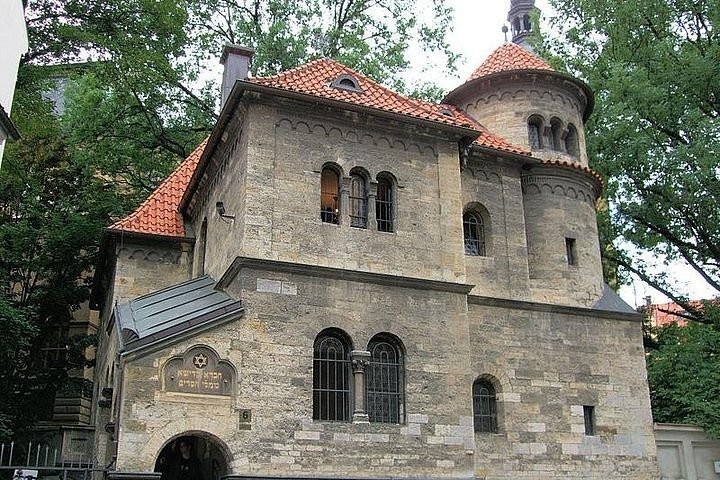
Nestled in the heart of Prague, the Jewish Quarter (Josefov) is one of the city’s most historically significant neighborhoods. This ancient district is a living testament to Prague’s rich Jewish history, culture, and heritage, offering a profound glimpse into the Jewish experience through centuries. With its centuries-old synagogues, museums, and memorials, Josefov is not just a place of reflection, but a vibrant hub of learning and remembrance. A visit to this poignant neighborhood is a must for anyone wishing to understand Prague’s diverse and layered history.
🌟 Highlights of the Jewish Quarter (Josefov)
• 🕍 Old-New Synagogue (Altneuschul)
The Old-New Synagogue, built in 1270, is one of Europe’s oldest active synagogues and an architectural gem. It has been a central place of worship for Prague’s Jewish community for centuries.
• 🏛️ Jewish Museum in Prague
The Jewish Museum, spread across several sites in Josefov, offers an extensive collection of Jewish artifacts, art, and historical exhibits. It provides deep insights into the history, culture, and life of Prague’s Jewish community.
• 🏰 The Jewish Cemetery
The Old Jewish Cemetery, with its layers of gravestones, is one of the oldest surviving Jewish burial grounds in Europe. With over 12,000 gravestones, it’s a poignant reminder of the city’s Jewish past, particularly during the times of the Austro-Hungarian Empire.
• 🕯️ Spanish Synagogue
This stunning synagogue, with its Moorish Revival architecture and beautiful interior, is known for its intricate decorative designs and history, dating back to the 19th century.
• 🏺 The Pinkas Synagogue
Now a Holocaust memorial, the Pinkas Synagogue is dedicated to the memory of over 77,000 Czech Jews who perished during the Holocaust. Its walls are inscribed with their names, making it a deeply moving tribute to their memory.
• 🏙️ The Jewish Town Hall
This historic building, with its unique clock tower, was the administrative center of the Jewish community for centuries. It’s an important part of the architectural fabric of Josefov.
🚗 How to Get There
• Public Transport:
Josefov is located within Prague’s central district, and it’s easily accessible by metro (line A to Staroměstská), trams, and buses. It’s a short walk from Old Town Square.
• On Foot:
You can easily walk to Josefov from other major attractions in Prague, including Old Town and Charles Bridge.
🕒 Visitor Information
• Opening Hours:
The Jewish Quarter is open year-round. The Jewish Museum and individual synagogues generally open from 9:00 AM to 6:00 PM, but check specific sites for varying hours.
• Entry Fee:
There is an entrance fee for the Jewish Museum and individual synagogues. A combined ticket is available for all major sites in the district.
• Recommended Visit Duration:
You’ll need 2–3 hours to explore the main attractions in the Jewish Quarter. If you’re keen on learning more, you could spend up to half a day here.
💡 Travel Tips
• 🎟️ Buy a Combined Ticket:
Consider purchasing a combined ticket for access to multiple sites in the Jewish Quarter. This can save you money and time.
• 📸 Respect the Sites:
The Jewish Quarter is a place of history and remembrance, so be respectful when visiting the synagogues, cemetery, and memorials.
• 🧭 Plan for Reflection:
Take time to reflect on the deep history and personal stories embedded in this district. Some sites, like the Pinkas Synagogue, can be quite moving.
• 🍽️ Explore Nearby Restaurants:
After your visit, enjoy a meal in the nearby Old Town, where you can savor Czech specialties or kosher fare in traditional eateries.
The Jewish Quarter (Josefov) is a deeply important part of Prague’s history, filled with rich cultural and emotional significance. Whether you’re exploring the historical synagogues, the poignant Old Jewish Cemetery, or reflecting on the stories of those who lived here, a visit to Josefov is both enlightening and humbling. This is a place that honors the Jewish community’s contributions and history in Prague and offers a space for remembrance and learning.
Dancing House (Tančící dům)
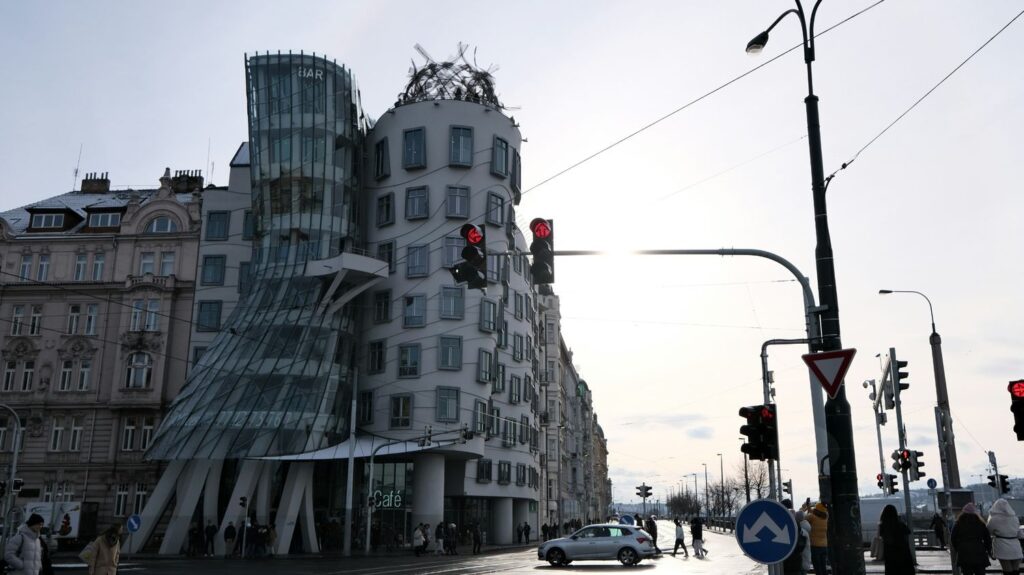
Photo by Thomas Gabernig on Unsplash
Situated along the Vltava River and contrasting with Prague’s medieval buildings, the Dancing House (Tančící dům) is a stunning example of modern architecture. Completed in 1996 by the architects Vlado Milunić and Frank Gehry, the building is a celebration of contemporary design and creativity, often referred to as the “Ginger and Fred” building due to its resemblance to a dancing couple. This architectural masterpiece has become one of Prague’s most beloved landmarks, offering a striking visual contrast to the city’s historic skyline.
🌟 Highlights of the Dancing House (Tančící dům)
• Iconic Design
The Dancing House is an eye-catching structure that defies the traditional architectural norms of Prague. Its flowing, curvaceous form contrasts with the rigid, classical buildings nearby. The building consists of two main parts: one looks like a traditional tower, while the other has a curvy, dynamic design representing the movement of a dancing couple. The design symbolizes the balance of opposites, much like the dynamic between Fred Astaire and Ginger Rogers, the names the building is affectionately given.
• Architectural Significance
Designed by Frank Gehry, known for his unconventional designs like the Guggenheim Museum in Bilbao, and Vlado Milunić, the Dancing House represents a bold step into the future for Prague’s architecture. Its construction was not without controversy, as many locals initially resisted the idea of modern design blending with the city’s classical style. However, the Dancing House now stands as a symbol of Prague’s forward-thinking and willingness to embrace innovation.
• Stunning Views from the Top
The Dancing House features a rooftop terrace with one of the best views of Prague’s skyline. From here, visitors can admire panoramic views of the Vltava River, Charles Bridge, and Prague Castle in the distance. It’s a fantastic spot for photos, particularly during sunset, when the golden light casts a beautiful glow over the city.
• The Ginger and Fred Restaurant
The top floor of the Dancing House is home to the Ginger and Fred Restaurant, a sophisticated dining spot offering both contemporary Czech and international cuisine. The restaurant’s modern interior design and views of Prague make it a great place for an elegant meal or cocktail while enjoying the view of the city.
• Art Gallery
The ground floor of the Dancing House houses an art gallery that often features contemporary exhibitions from both Czech and international artists. It’s a great place to experience Prague’s vibrant art scene and adds another layer of creativity to this already artistic landmark.
🚶♂️ How to Get There
• By Metro:
The nearest metro station is Karlovo náměstí (Line B – Yellow Line), which is a short walk from the Dancing House.
• By Tram:
Trams 3, 9, 14, and 24 stop near the Jiráskovo náměstí tram station, which is just a few minutes from the Dancing House.
• On Foot:
The Dancing House is located within walking distance from Prague’s Old Town and Wenceslas Square. It’s an easy 15-minute walk from Charles Bridge, passing through the charming Nové Město district along the way.
🕒 Visitor Information
• Opening Hours:
The Dancing House itself is open to visitors 24/7, but the Ginger and Fred Restaurant is open daily from 12:00 PM to 11:00 PM. The art gallery on the ground floor has varying hours, typically open from 10:00 AM to 6:00 PM.
• Entry Fee:
While visiting the Dancing House itself is free, access to the rooftop terrace costs around 200 CZK (about 8 EUR). The art gallery typically has free entry, though special exhibitions may require an entrance fee.
• Recommended Visit Duration:
A visit to the Dancing House can take anywhere from 30 minutes to an hour. If you plan to dine at the restaurant or explore the gallery, allow an additional 1-2 hours.
💡 Travel Tips
• 🎟️ Visit During Sunset for the Best Views:
The rooftop terrace offers stunning views of Prague, and sunset is one of the best times to visit. The city is bathed in warm light, providing fantastic photo opportunities.
• 👟 Explore the Surroundings:
The Dancing House is located in the Nové Město district, which is home to various cafés, shops, and cultural landmarks like the Vyšehrad Fortress and National Theatre. Take the time to explore the area after visiting the Dancing House.
• 🍽️ Dining at Ginger and Fred Restaurant:
If you’re planning to dine at Ginger and Fred, it’s advisable to make a reservation, especially during peak hours. The restaurant is popular not only for its cuisine but also for its unique setting and views.
• 📸 Perfect for Photos:
Don’t forget to bring your camera! The Dancing House provides endless angles and perspectives for photography, whether you’re taking wide shots of the building or capturing its stunning silhouette against the city’s skyline.
The Dancing House (Tančící dům) is a must-see landmark in Prague that showcases the beauty of modern architecture amidst a historic cityscape. Whether you’re marveling at the building’s unique design, soaking in the panoramic views of Prague from the rooftop terrace, or experiencing the contemporary art gallery, the Dancing House is an essential stop for anyone interested in the city’s architectural and artistic scene. It’s the perfect blend of innovation and tradition, and it beautifully complements Prague’s rich cultural heritage.
Vyšehrad Fortress
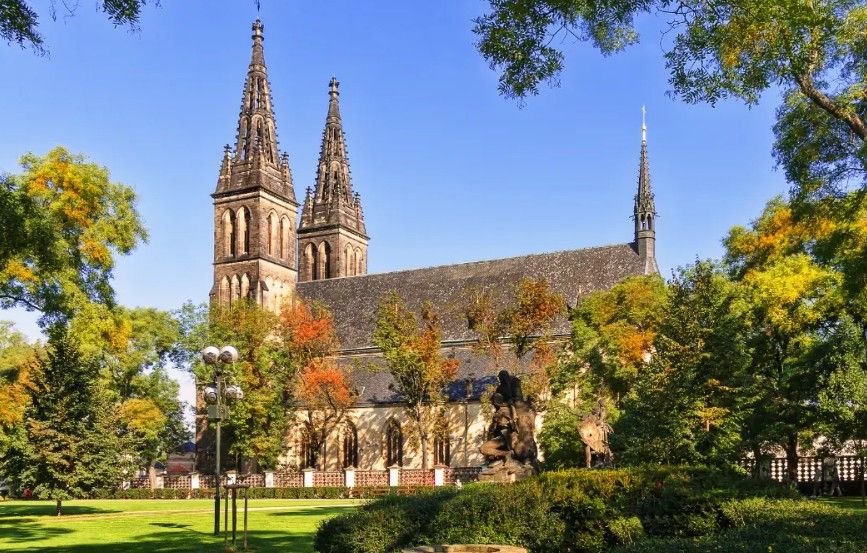
Perched high above the Vltava River on a hill, Vyšehrad Fortress is one of Prague’s oldest and most significant historic sites. Often overshadowed by the grandeur of Prague Castle, Vyšehrad offers a more peaceful and reflective atmosphere, making it a perfect destination for history enthusiasts and those seeking stunning panoramic views of the city. With its ancient ramparts, scenic gardens, and impressive architectural landmarks, Vyšehrad is a hidden gem that tells the story of Prague’s early history and its cultural heritage.
🌟 Highlights of Vyšehrad Fortress
• 🏰 Vyšehrad Castle and Ramparts
Explore the ancient walls and ramparts of Vyšehrad Fortress, which date back to the 10th century. The castle offers an incredible view of Prague’s skyline, including Prague Castle and the Vltava River.
• ⛪ St. Peter and Paul Basilica
This neo-Gothic basilica is one of Vyšehrad’s most striking landmarks. Admire its grand spires, intricate stained glass windows, and peaceful interior, which offers a serene escape from the city hustle.
• 🏙️ Vyšehrad Cemetery
This historic cemetery is the final resting place of many famous Czechs, including composers, writers, and national heroes. It’s an emotional place to reflect on Czech culture and heritage.
• 🌳 Vyšehrad Gardens
Relax in the beautiful gardens surrounding the fortress. These well-maintained green spaces offer perfect spots for picnics, leisurely walks, and photography, all while enjoying the tranquil atmosphere.
• 🎨 The Slavin Memorial
The Slavin Memorial, located in Vyšehrad Cemetery, is a significant monument dedicated to Czech national heroes who died during World War II. It serves as a moving tribute to the sacrifices made by the Czech people.
🚗 How to Get There
• Public Transport:
The easiest way to reach Vyšehrad is by metro (line C to Vyšehrad station). From there, it’s a short walk uphill to the fortress.
• On Foot:
If you’re already in the city center, Vyšehrad is about a 20-minute walk from Wenceslas Square or Karlovo náměstí.
🕒 Visitor Information
• Opening Hours:
Vyšehrad Fortress is open year-round. The grounds and the St. Peter and Paul Basilica are usually accessible from 8:00 AM to 6:00 PM.
• Entry Fee:
The entrance to Vyšehrad’s grounds is free, though there are fees for entering the St. Peter and Paul Basilica and the Vyšehrad Cemetery.
• Recommended Visit Duration:
Spend about 1.5 to 2 hours exploring Vyšehrad Fortress, allowing time to wander the ramparts, visit the basilica, and enjoy the peaceful gardens.
💡 Travel Tips
• 📸 Great Views for Photos:
Vyšehrad offers one of the best panoramic views of Prague, especially over Prague Castle and the Vltava River. Don’t forget your camera!
• 🎶 Cultural Heritage:
Vyšehrad is not only a historic site but also an important cultural landmark, with the cemetery home to famous figures like Antonín Dvořák and Bedřich Smetana.
• 🧭 Take Your Time:
Unlike the more crowded Prague Castle, Vyšehrad offers a peaceful atmosphere. Take your time exploring its green spaces, historic buildings, and monuments.
• ☕ Relax at a Café:
There are a few charming cafés in the Vyšehrad area where you can take a break, enjoy a coffee, and reflect on your visit.
Vyšehrad Fortress offers an authentic slice of Prague’s history, providing stunning views, rich cultural experiences, and a peaceful ambiance away from the tourist crowds. Whether you’re wandering through the fortress walls, admiring the basilica, or reflecting at the Vyšehrad Cemetery, this historic site offers a beautiful blend of history, art, and nature. It’s an ideal place for those looking to explore Prague beyond the usual tourist spots.
💡 Local Tips for Travelers
- Tipping: Not expected, but rounding up or leaving 5–10% is appreciated.
- Tap water: Safe to drink.
- Safety: Generally very safe—just watch for pickpockets in busy tourist spots.
- Cash vs Card: Cards accepted in most places, but it’s smart to carry some CZK for small shops or public restrooms.
✨ Final Thoughts
Prague feels like stepping into a storybook—where every corner tells a tale, every alley leads to discovery, and every meal is a celebration of flavor and tradition. Whether you’re chasing history, architecture, or a bit of romance, Prague delivers beauty, charm, and value in equal measure.
So lace up your walking shoes, charge your camera, and let the magic of Prague sweep you off your feet. 💫
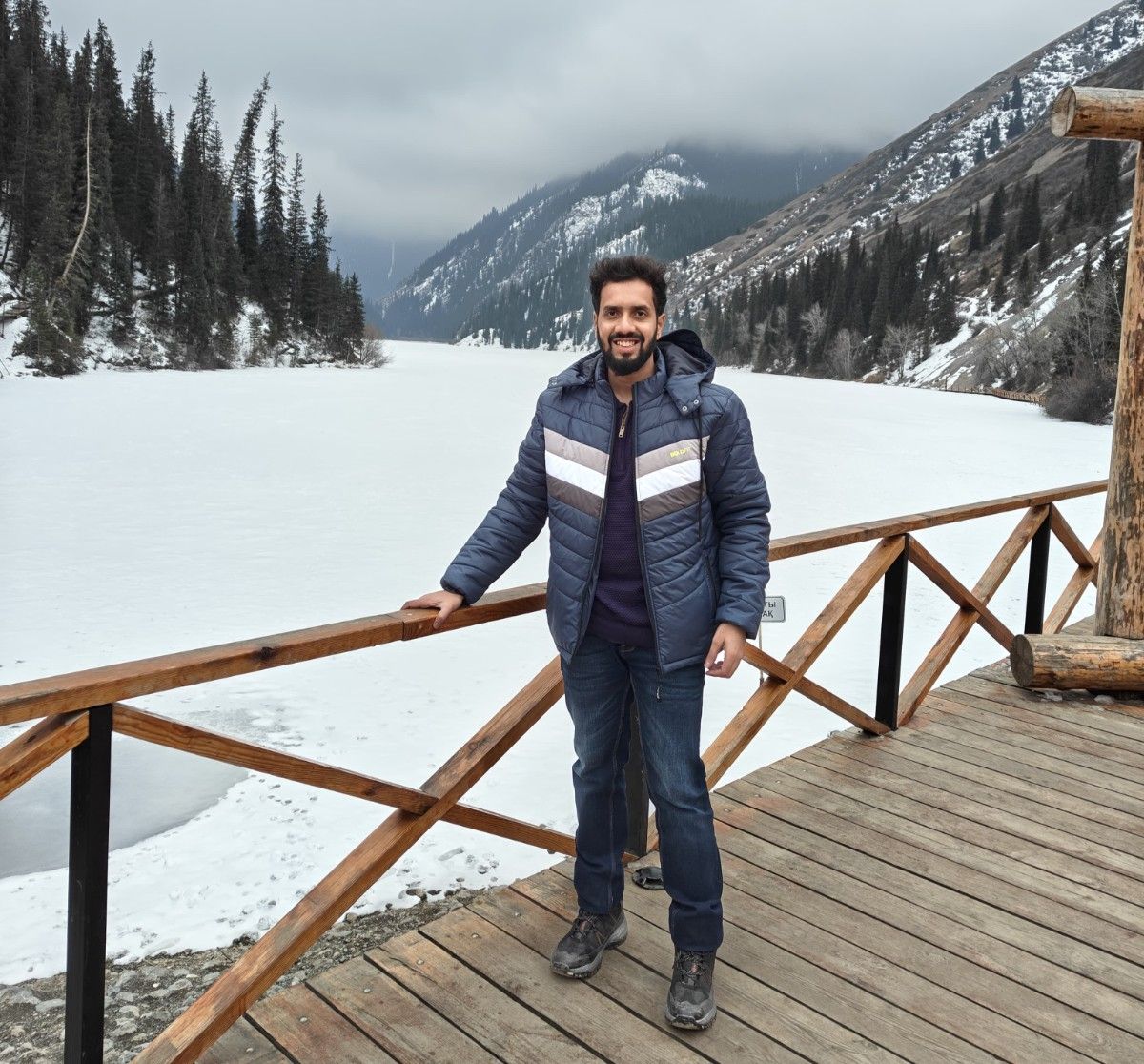
I’m Shreyash Mhashilkar — a full-stack developer by profession, and a passionate explorer of the future at heart.
With a strong foundation in both front-end and back-end , I spend my days building websites and applications that are not just functional, but scalable, intuitive, and user-focused.

